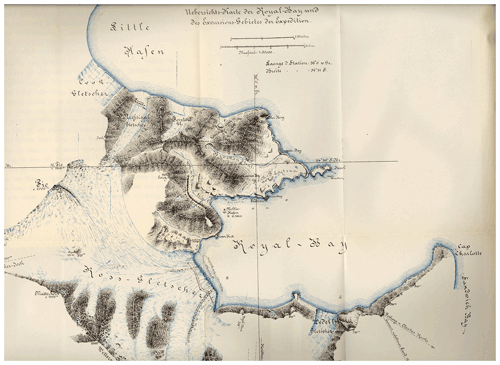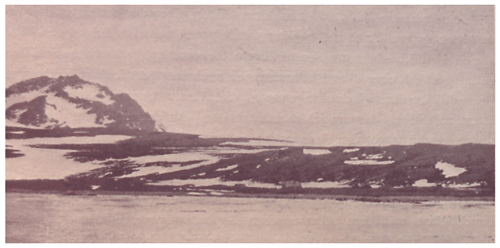the Creative Commons Attribution 4.0 License.
the Creative Commons Attribution 4.0 License.
140 years ago: the German station at South Georgia (South Atlantic) of the First International Polar Year (1882–1883)
Cornelia Lüdecke
During the First International Polar Year (1882–1883) in the Arctic, Germany set up a meteorological and magnetic station at South Georgia in the South Atlantic, where the transit of Venus in front of the Sun on 6 December 1882 could also be observed. After the return of the expedition the station decayed over the years. Otto Nordenskjöld's Swedish Antarctic expedition and Wilhelm Filchner's German Antarctic expedition passed by in 1902 and 1911, respectively, and gave some information about the status of the huts and scientific installations. 100 years after the polar year only some relics remained. The paper describes the historical station and wants to encourage an archeological investigation to learn more about the social life of the station members.
- Article
(10212 KB) - Full-text XML
- BibTeX
- EndNote
When meteorologists agreed upon an International Polar Year with synchronous meteorological and magnetic measurements in the Arctic from 1 August 1882 until 1 September 1883, Georg Neumayer, director of the German Marine Observatory in Hamburg, pleaded for an additional observatory on South Georgia in the Southern Hemisphere (Barr and Lüdecke, 2010; Tammiksaar et al., 2010). Besides the synchronous measurements according the international cooperation in meteorology and magnetism, the southern observatory would also allow participating in another international cooperation, i.e., the observation of the transit of Venus in front of the Sun on 6 December 1882 (Bucher, 2011, pp. 176–185). It was very important for this cooperation to operate many stations widely distributed over the area of visibility in the eastern part of North America, Central America, and South America (Fig. 1) (Newcomb, 1881).
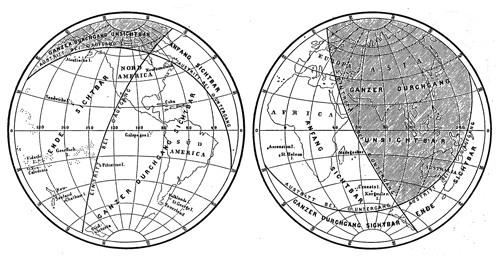
Figure 1Area of full visibility of the transit of Venus in front of the Sun's disk on 6 December 1882 (source: Newcomb, 1881, p. 219).
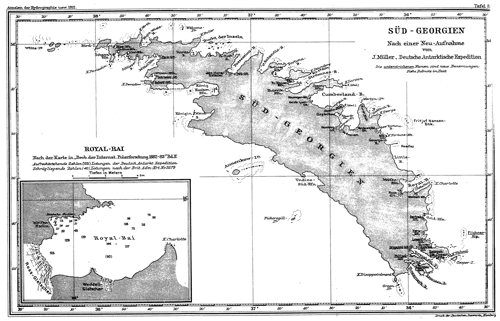
Figure 2Maps of South Georgia and Royal Bay constructed by Johannes Müller, a member of the German Antarctic expedition (1911–1912). Depth given in meters (source: Müller, 1912).
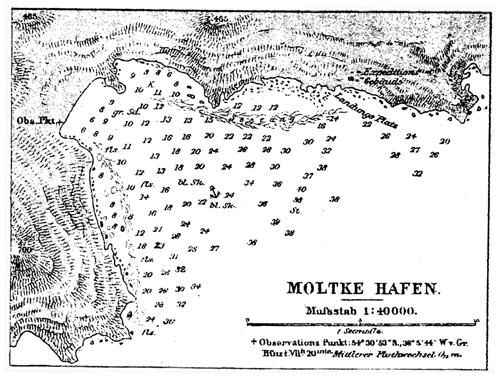
Figure 3Moltke Harbour in Royal Bay (South Georgia). Heights and depths in meters (source: Annalen, 1883, Table 3).
If you observe the transit from different (and preferably from the most distant) places together with the exact time of entrance and departure of Venus in front of the Sun's disk you can calculate the distance between the Sun and Earth, which results in the astronomical unit. This value had yet to be determined more exactly at that time. With the argument of wanting to observe the transit of Venus from a very remote southern location, Neumayer tried to acquire funds for this additional southern observatory. Otherwise, it would not have made much sense in the context of the Arctic cooperation of the polar year except for synchronous magnetic measurements and observations of the polar lights. In consequence, this additional expedition is not well known in the context of the International Polar Year in the Arctic, and its results are not included in the official data set.
Only 1 year before the start of the agreed polar year, the German Emperor Wilhelm II granted financial support for the expedition to Cumberland Bay on the eastern coast of South Georgia (South Atlantic) (Auwers, 1888; Neumayer, 1891). When the German expedition on board the naval corvette Moltke entered the southern part of Cumberland Bay, weather and waves prevented a landing at the envisaged place (Fig. 2).
Finally, the station was established further to the south in Moltke Harbour at 54∘31′00′′ S and 36∘0′00′′ W, 6.50 m above sea level in the middle of the northern shore of Royal Bay; it was finished on 3 September 1882. At the same time, the ship's crew performed soundings of Moltke Harbour. The map of Moltke Harbour was immediately published in the German Annalen der Hydrography und Maritimen Meteorologie (Fig. 3), while the map of the surrounding of Royal Bay only followed in 1891 (Fig. 4).
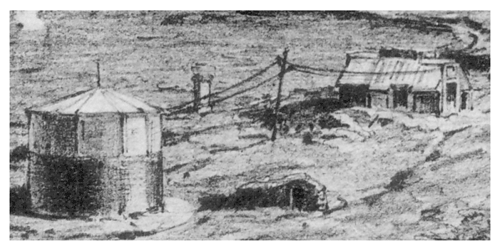
Figure 5The German astronomical observatory at Royal Bay (source: detail from Neumayer, 1891, p. 100).
The station leader was astronomer Karl Schrader from Braunschweig. He was accompanied by the professor of physics and mathematics at the Militär-Bildungsanstalt (military educational institution) in Munich, Peter Vogel, the physician and natural scientist, Karl von den Steinen from Mühlheim an der Ruhr, the botanist Hermann Will from Erlangen, the physicist and assistant O. Clauß from Mannheim, the engineer and assistant E. Mosthaff from Munich, and the mechanic and assistant A. Zschau from Dresden. Additionally, there was the cook R. Fürth, the carpenter H. Beckmann (both from Hamburg), the sailmaker W. Weinschläger from Wolgast, the seaman H. Maass from Warnemünde to take care of everything, and finally a dog called Banquo. Unfortunately, the surnames of these men are not mentioned in the reports. This group of 11 men arranged the interior of their dwelling house as nicely as possible.
Apart from the comparatively large hut they built an astronomical observatory for the determination of the exact time, latitude, and longitude, a turning dome with an iron framework to observe the transit of Venus, and a darkroom from moss put above a wooden framework close to the turning dome (Fig. 5). An absolute hut and a variation hut for Earth magnetic measurements as well as a Stevenson screen for meteorological instruments were also set up (Fig. 6).
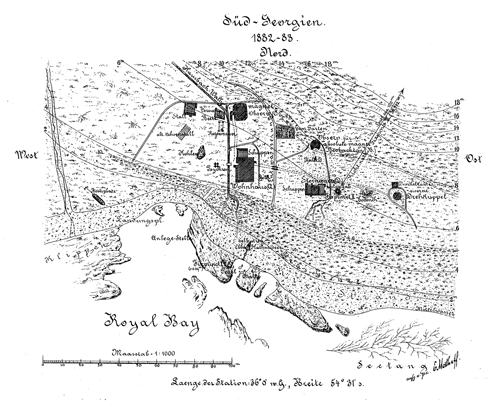
Figure 6Plan of the German polar year station at Royal Bay (1882–1883) (source: Neumayer and Börgen, 1886, VIII).
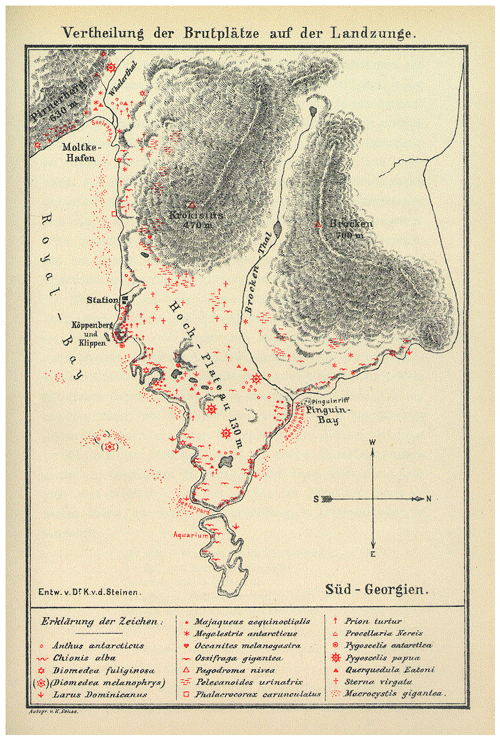
Figure 7Breeding grounds on the northern headland of Royal Bay, South Georgia (source: Neumayer, 1890, p. 194).
A small hut for the carpenter and for supplies was connected to the north side of the dwelling house. The zoological laboratory was connected to the east side of the astronomical observatory. Additional meteorological instruments (psychrometer, rain gauge, Earth thermometer) were set up at various places. A landing place for the little whaler's boat and a place for the boat on the shore were also provided, as was a tide gauge.
The most interesting installation was a stable for livestock (three oxen, 17 wethers, six goats, and three kids). When the livestock changed during their stay, a new smaller stable was in use since April 1883 for two wethers and two goats, while one ox as well as two older and two younger goats were kept and grazed outside. In addition, the men tried to maintain a garden for vegetables and an additional experimental garden of 4 m2.
The daily routine of regular meteorological and magnetic measurements was interrupted by the observation of the transit of Venus on 6 December 1882. Although it was very stormy during that day and the cupola was shaking a lot, the sky was clear and the Sun visible during the transit. In the end the observation was successful (Barr, 2008, pp. 279–305). In addition to the observations and when time allowed, station members made excursions in the neighborhood to investigate the surroundings and to start a geological collection. The results of the zoological survey, for example, were summarized in a map (Fig. 7).
On their return from excursions and on feast days, the station members liked to drink typical Bavarian beer sponsored by the brothers Carl und Anton Sedlmayr from Spaten Bräu in Munich (Schrader, 1883). In their honor they gave the name Sedlmayer Glacier to the big glacier that could be seen southwest of Pirner Peak, which was later officially called Ross Glacier. Birthdays, Christmas, and New Year's Eve were special occasions to enjoy a wonderful dinner accompanied by a good drink (Fig. 8).
When the expedition returned to Germany, meteorological and magnetic data were analyzed according to the regulations of the international cooperation (Neumayer und Börgen, 1886). The optional geological, botanical, and zoological collections were also evaluated and included in the results of the International Polar Year 1882–1883. Except for rare and short overnight stays, the remaining station was not used again during the following years (Headland, 1984).
Geologist Otto Nordenskjöld, leader of the Swedish Antarctic Expedition (1901–1903), visited the German station at Royal Bay in 1902 on his way to the Weddell Sea, when the dwelling house was still standing and in a good condition (Nordenskjöld, 1904, p. 35) (Abb. 9). They entered the hut and found a notice from the whalers of the ships Castor and Hertha on the wall indicating their visit in 1901. There were a lot of vegetables left over in other parts of the hut, which were mostly rotten due to humidity and mold. Only t peas, t white beans, and t oats were still edible. In contrast, the astronomical and magnetic observatories were badly battered. Strong storms took the roofs away and one of the little huts had been nearly blown over.
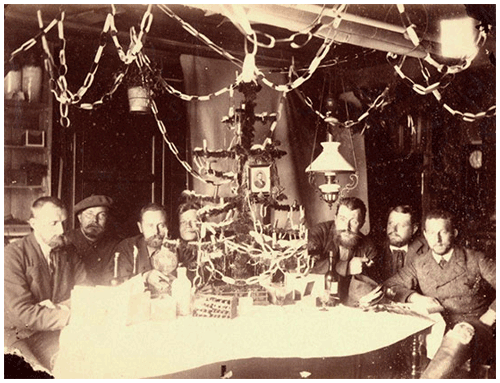
Figure 8Scientists and assistants of the German station at Christmas dinner, Royal Bay, South Georgia, 1882. From left to right: Karl Schrader, Peter Vogel, Karl von den Steinen, mechanic A. Zschau, ingeneer E. Mosthaff, Hermann Will, O. Clauß (source: Kretzer und Krause, 2007, p. 45).
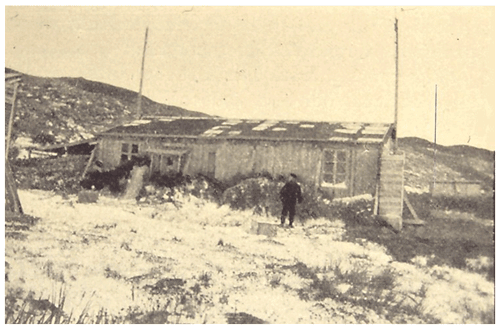
Figure 9The accommodation hut of the German station in Royal Bay in 1902 (source: detail Nordenskjöld, 1904, vol. 2, p. 34).
After their return to Sweden, the captain of Nordenskjöld's expedition ship, the Norwegian Carl Anton Larsen, founded the Argentine Fishing Company (Compañía Argentina de Pesca) in 1904 and set up the first whaling station at South Georgia in Grytviken on the western shore of the southern part of Cumberland Bay.
The next published visit to the polar year station was described by the German officer and explorer Wilhelm Filchner, leader of the German Antarctic expedition (1911–1912) (Filchner, 1922, p. 98). During his expedition to the Weddell Sea, the meteorological and magnetic measurements of the International Polar Year were to be repeated in Royal Bay in the southern spring of 1911, in particular to be able to determine the change in the magnetic field. Larsen had wanted to repair the dwelling house of the polar year at Royal Bay for this purpose weeks ago, but heavy snowfall and large drifts prevented his plan. Therefore, Larsen gave Filchner a carpenter in addition to the materials needed for the repairs. On 24 October, four Germans (Filchner, the astronomer and Earth magnetician Erich Przybyllok, the ship's doctor Wilhelm von Goeldel, and the nameless carpenter) were taken to Royal Bay on the steamer Udine of the whaling station. The huts of the German polar year station were still standing but were already in a rather desolate condition (Fig. 10).
After the night in the rather uncomfortable tent, the men checked the dwelling house for habitability on the following day (Filchner, 1922, pp. 99–110, 124). It was filled with snow up to a height of more than 2 m, which had penetrated through the damaged roof over the years. Otherwise, it was in surprisingly good condition. The small provision room was reasonably okay and could be used as living space right away. They patched the roof with corrugated metal sheets and removed the snow with ice picks and shovels. The remaining layer of ice, still several inches thick on the floor, was simply covered with a board floor. Fortunately, they still found two intact window sashes with four unbroken panes of glass, which they could use to cover the window in a makeshift fashion. Finally, the shelves on the wall of the provision room were converted into three bunks. With that, the station house was back in operation. The different observatories, however, had been destroyed by wind and weather. Even the pillars for the astronomical observations had been knocked over. Only the iron rotating dome of the observatory was still intact. After the repairs were finished and the start of the measurements, Filchner and the doctor were picked up on 26 October, while Przybyllok and the carpenter remained for the measurements until 19 November 1911.
Further references to the station and a description of a visit to the remains in 1982 were given in Headland (1982). Headland visited the location of the German polar year station a hundred years after its establishment, which had totally decayed. All walls of the buildings were down, and the metal cupola of the astronomical dome, the hearth, and stoves were rusty and distributed in the surroundings. A collection of empty bottles of wine, spirits, and carbonated water was found between the remains of two buildings.
The unused German station from what today is the so-called First International Polar Year (1882–1883) at South Georgia (South Atlantic) finally reached the stage of being a historical object. It represents a temporary observatory set up for the last important observation of the transit of Venus in 1882 before new methods were available to determine the astronomical unit more precisely. It also represents the first meteorological and magnetic station on South Georgia, which was working throughout all seasons of the year. Besides the geophysical and astronomical data as well as biological collections, little information is left about the living conditions of the station members. The unpublished station book, written by all station members, only covers the time from 20 September 1882 until 4 March 1883. More diaries or personal letters are not known to the author.
It would be very interesting to start some archeological investigations of the German polar year station, especially of the rubbish dumps around the huts, to learn more about the outline of the station and how people were living and working there over 140 years ago. There are several groups which might be involved in such an investigation, for instance the South Georgia Heritage Trust (SGHT, 2022), the International Polar Heritage Committee (IPHC, 2022) as part of the framework of the International Council of Monuments and Sites, and the Standing Committee on the Humanities and Social Sciences (SC-HASS, 2022) of the Scientific Committee on Antarctic Research. The first steps of cooperation were already initiated some years ago, but “Brexit” and the corona pandemic have stopped all activities in this direction until today.
The data from the meteorological and magnetic polar year station are available in Neumayer (1891) and Neumayer and Börgen (1886).
The author declares that there is no conflict of interest.
Publisher's note: Copernicus Publications remains neutral with regard to jurisdictional claims in published maps and institutional affiliations.
I want to thank Hans-Jochen Kretzer from the Neumayer-Archiv, Neustadt a.d. Weinstraße, for permission to publish the picture of the Christmas dinner at South Georgia as well as the reviewers for their useful comments.
This paper was edited by Jens O. Herrle and reviewed by Volker Dr. Strecke and one anonymous referee.
Annalen: Annalen der Hydrographie und Maritimen Meteorologie, 1, Table 3, 1883.
Auwers, A. V.: Die Venusdurchgänge 1874 und 1882, Bd. 3, Die Beobachtungen der Expeditionen von 1882, Reichsdruckerei, Berlin, 1888.
Barr, W.: The expeditions of the First International Polar Year, 1882–83, Arctic Institute of North America, Calgary, 2008.
Barr, S. and Lüdecke, C.: South Georgia, in: The History of the International Polar Years (IPYs), edited by: Barr, S. and Lüdecke, C., From Pole to Pole, Vol. 1, Springer, Berlin, Heidelberg, 54–58, https://doi.org/10.1007/978-3-642-12402-0_3, 2010.
Bucher, G.: Die Spur des Abendsterns: die abenteuerliche Erforschung des Venustransit, Wissenschaftliche Buchgesellschaft, Darmstadt, 2011.
Filchner, W.: Zum sechsten Erdteil, Ullstein, Berlin, 1922.
Headland, R. K.: The German Station of the first International Polar Year, 1882–1883 at South Georgia, Falkland Island Dependencies, Polar Rec., 21, 287–301, 1982.
Headland, R.: The Island of South Georgia, Cambridge University Press, Cambridge, 1984.
IPHC: International Polar Heritage Committee, http://iphc.icomos.org/, last access: 4 October 2022.
Kretzer, H.-J. und Krause, R. A.: Station der Deutschen Polar-Kommission in Süd-Georgien, Royal Bay, 1882–83, POLLICHIA-Sonderveröffentlichung Nr. 11, Eigenverlag der POLLICHIA, Bad Dürkheim, 2007.
Müller, J.: Süd-Georgien. Annalen der Hydrographie und Maritimen Meteorologie, Tafel 8, 1912.
Neumayer, G. (Ed.): Die internationale Polarforschung 1882–1883. Die deutschen Expeditionen und ihre Ergebnisse, Bd. 2, Beschreibende Naturwissenschaften, Asher, Berlin, 1890.
Neumayer, G. (Ed.): Die internationale Polarforschung 1882–1883. Die deutschen Expeditionen und ihre Ergebnisse, Bd. 1, Geschichtlicher Theil, Asher, Berlin, 1891.
Neumayer, G. B. und Börgen, C. N. J.: Die Beobachtungs-Ergebnisse der Deutschen Stationen, Vol. 2, Süd-Georgien und das magnetische Observatorium der kaiserlichen Marine Wilhelmshaven, Asher, Berlin, 1886.
Newcomb, S.: Populäre Astronomie, Bearb. durch Rud. Engelmann, Engelmann, Leipzig, https://www.digitale-sammlungen.de/de/view/bsb11554996?page=,1 (last access: 26 October 2022), 1881.
Nordenskjöld, O.: Antarctic. Zwei Jahre in Schnee und Eis am Südpol, Dietrich Reimer, Berlin, Vol. 2, https://archive.org/details/bub_gb_6LJCAAAAYAAJ (last access: 26 October 2022), 1904.
Schrader, K.: Private Diary of the members of the German Expedition to South Georgia 1882 Sept. 20–1883 March 4, in private possession, Oskar Reinwarth, Ottobrunn. 1883.
SC-HASS: Standing Committee on the Humanities and Social Sciences, https://www.scar.org/science/hass/humanities/, last access: 4 October 2022.
SGHT: South Georgia Heritage Trust, https://sght.org/, last access: 4 October 2022.
Tammiksaar, E., Sukhova N. G., and Lüdecke, C.: International Polar Year (1882–1883), in: The History of the International Polar Years (IPYs), edited by: Barr, S. and Lüdecke, C., From Pole to Pole, Vol. 1, Heidelberg, Springer, Berlin, 7–33, https://doi.org/10.1007/978-3-642-12402-0_2, 2010.






